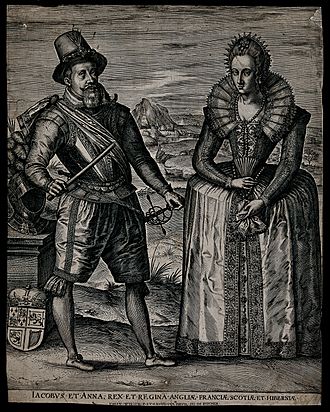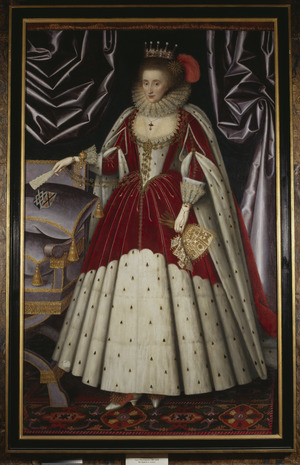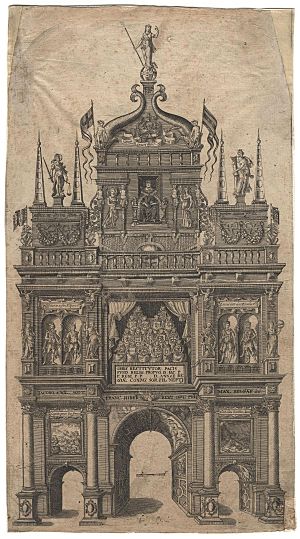Coronation of James I and Anne facts for kids
Quick facts for kids 
James and Anne in an engraving by Jan Wierix, 1610s
|
|
| Date | 25 July 1603 |
|---|---|
| Location | Westminster Abbey, London, England |
| Participants |
|
The coronation of James I and his wife Anne was a special ceremony. It made them the official King and Queen of England and Ireland. This important event took place on 25 July 1603 at Westminster Abbey in London.
Before this, James had already been King James VI of Scotland since 1567. During the ceremony, Queen Anne was blessed with special prayers, like those for important women in the Bible. This coronation was also very special because it was the first one done in English, not Latin. A big parade in London, called a "Royal Entry," was planned but had to be postponed until 15 March 1604.
Contents
Why was the Coronation Held?
After Elizabeth I passed away on 24 March 1603, James VI of Scotland became the new King of England. This moment is known as the Union of the Crowns, as it brought the crowns of Scotland and England together under one ruler. James had already been crowned King of Scotland on 29 July 1567 at Stirling. His wife, Anne of Denmark, had also been crowned Queen in Edinburgh on 17 May 1590.
James traveled to England and arrived at Theobalds on 3 May 1603. Queen Anne followed him later, after she had been unwell at Stirling Castle.
Challenges for the Ceremony
Plans for the coronation faced big problems because of a serious sickness called the plague. To keep people safe, the number of guests and officials allowed inside Westminster Abbey was greatly limited. This made the coronation much quieter than usual. Some people even said that a later ceremony at Windsor Castle was much grander.
However, historians now understand that King James had different priorities. He wanted to make sure the ceremony happened on time.
Planning the Event
A special group was set up to decide who had the right to do certain jobs at the ceremony. On 18 July, this group announced that the usual parade through the city would be much shorter. There was also no traditional feast after the crowning.
The date of the ceremony, 25 July, was kept because it was a lucky day. It was the feast day of Saint James, who was the king's name saint. Also, important political events made James eager to take his coronation promises and "settle his affairs."
New items were made for the coronation. A new imperial crown was created. Goldsmiths William Herrick and John Spilman made a special canopy for the Abbey, decorated with pearls and fake jewels. They also made a jeweled circlet (a small crown) for Anne of Denmark. Some of the gems for Anne's circlet came from the jewels of Elizabeth I.
The special group made its final decisions on who got which honors on 24 July. They didn't decide on all claims. For example, Sir Oliver Leigh claimed he had the right to provide a special dish of "herout or pigernout" for the royals. His family had claimed this right at earlier coronations too.
The Chancellor of the Exchequer, John Fortescue of Salden, was in charge of the money spent. About £5,000 was spent on the coronation. For safety, James asked for 100 soldiers from Surrey. Another 500 soldiers were hired to guard against "any tumults and disorder" in Westminster and the Strand. People were also kept away from the royal family to prevent the spread of the plague. It was even forbidden to watch from boats on the river.
The Coronation Ceremony


The English Reformation had changed how coronations were done, as old ceremonies included Roman Catholic traditions. So, a new version of the Liber Regalis (a 14th-century coronation guide) was made. It removed anything that didn't fit with the Anglican church. Most of the ceremony was translated into English, but some parts stayed in Latin. The coronation oath was said in Latin, English, and French.
On Sunday, 24 July, James created several new Knights of the Bath at Whitehall Palace. The next day, James and Anne traveled by a fancy royal boat from Whitehall to Westminster. They then walked to Westminster Hall. It was raining. Even though people were told to stay away because of the plague, the streets and river were full of onlookers.
The Queen's long velvet train was held by one of her ladies and her chamberlain. This honor was argued over by two different people.
The Procession and Crowning
The ceremony was described by several diplomats who were there. They saw a parade of heralds (official messengers), followed by the mayor and city leaders, lawyers, judges, and important nobles. King James walked under a special canopy, followed by his household and guards.
Queen Anne of Denmark walked under a similar canopy. She wore robes of crimson velvet lined with ermine (a type of fur). She was accompanied by Arbella Stuart and a dozen countesses carrying small crowns. These included Lucy Russell, Countess of Bedford, Helena Snakenborg, Marchioness of Northampton, and the Countess of Cumberland.
James and Anne sat in front of the main altar on special chairs. John Whitgift, the Archbishop of Canterbury, crowned James. James then changed into old robes said to have belonged to Edward the Confessor. He then sat on the Coronation Chair, which holds the famous Stone of Scone. After Anne was crowned, she sat next to him on a slightly lower throne.
James took communion (a religious ritual), but Anne did not. It was said that she had strongly refused to do so that morning.
The Stone of Scone
People at the time believed there was a special connection between the Scottish king becoming King of England and the use of the stone from Scone Palace. A Latin poem about the stone meant that it kept its importance no matter where it was.
Music at the Coronation
We don't have a full description of all the music played. The procession from Westminster Hall to Westminster Abbey probably had an anthem called O Lord, grant the King a long life. Other songs were played during different parts of the ceremony, like Behold, our Lord and protector and The King shall rejoice. It's not clear who wrote all the music, but Thomas Tomkins and William Byrd likely contributed.
Coronation Costumes


The Earl of Oxford had the right to dress the king. James wore a crimson velvet cloak over a velvet coat lined with ermine, and a velvet and ermine cap. The earls wore gold coronets instead of hats. James's outfit was probably made by his Scottish tailor, Alexander Miller.
A wooden model of James, possibly wearing his coronation robes, is at the National Museum of Scotland. A painting by Paul van Somer shows James in his ermine-lined robes over white satin clothes.
Queen Anne's coronation costume was made of crimson and purple velvet, lined with ermine, and smelled of musk and ambergris. Her dress was simple, without embroidery, and her hair was loose around her shoulders, with a jeweled gold circlet on her head. It was a tradition for queens to wear their hair loose for their coronation.
Nobles were given directions on what to wear. The Earl and Countess of Shrewsbury paid £50 for their gold coronets. The Earl of Shrewsbury had the honor of supporting the king's right arm during the procession.
Paintings of countesses in their ermine gowns show two styles of skirts. Some wore an older French-style skirt, while others wore the newer, wider "drum" or "French-wheel" farthingales. The use of a lot of ermine, especially on the front of the skirt, was similar to the robes Elizabeth I wore.
One diplomat noted that the countesses wore scarlet dresses in an "antique fashion" trimmed with ermine. This might have meant they had wide sleeves or that their red and white costumes looked like the colors of Franconia.
Lady Anne Clifford's parents attended the coronation. Her mother, the Countess of Cumberland, had to ask for help to buy suitable clothes because she was having financial problems. Anne Clifford herself was not allowed to attend because of fears about the plague in the city.
Royal Travels After the Coronation
After the ceremony, the King and Queen went to Westminster Palace, and then to Hampton Court the next day. They also stayed at Richmond Palace and Woodstock Palace in Oxfordshire. The court then traveled west to Winchester and Wilton House to avoid the continuing plague in London. Because of the plague, the July St James Fair and the August Bartholomew Fair in London were canceled.
Royal Entry to London
Special arches and displays were built in London for the coronation parade, which was postponed to 15 March 1604 because of the plague. One writer, John Chamberlain, described them in July 1603 as being a bit flimsy.
The city of London spent at least £4,100 on these displays. Many city companies also helped, providing stands for their members and banners. The total amount spent on these city displays was similar to the cost of the coronation robes worn by James and Anne.
Several of the arches were designed by Stephen Harrison. Thomas Dekker wrote about the event, saying the streets were packed with people.
The parade was described by the Spanish and Venetian ambassadors. James, Anne, and Prince Henry stayed at the Tower of London. On Wednesday, 15 April, James rode through the city, followed by Henry. Then Anne came in a carriage pulled by mules, with Arbella Stuart in another carriage. Queen Anne showed great interest in the crowds, which people liked. King James, however, seemed a bit impatient with how curious everyone was.
A poem by Dekker called Troynovant compared London to a new Troy. It used the idea of James becoming king of four kingdoms as a marriage. A few days later, Parliament was opened with another ceremony. There were also jousting events on Saturday, 24 March, which was celebrated as the king's accession day.
Images for kids




